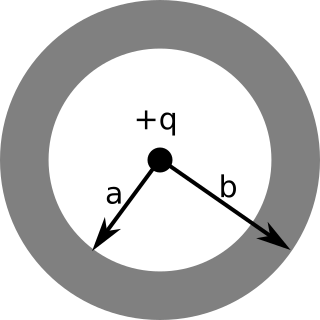Homework 10 (Due November 8th)
Homework 10 focuses on developing ideas about the D-field including how to apply Gauss’ Law for $\mathbf{D}$ and the relationships between $\mathbf{D}$, $\mathbf{E}$, and $\mathbf{P}$. At the end of this problem set is a problem for you and partner to complete as a review for the upcoming exam.
1. Bound charges and the D-field
Consider a long teflon rod, (a dielectric cylinder), radius $a$. Imagine that we could somehow set up a permanent polarization $\mathbf{P}(s,\phi,z) = k\mathbf{s} ( = ks\hat{s})$, where $s$ is the usual cylindrical radial vector from the $z$-axis, and $k$ is a constant). Neglect end effects, the cylinder is long.
- Calculate the bound charges $\sigma_{bound}$ (on the outer surface) and $\rho_{bound}$ (in the interior of the rod). What are the units of your constant $k$? Show that the units work out in all formulas you have used involving $k$.
- Next, use these bound charges (along with Gauss’ law, this problem has very high symmetry!) to find the electric field, $\mathbf{E}$ inside and outside the cylinder. (Your answer should include both the direction and magnitude.)
- Finally, determine the electric displacement field ($\mathbf{D}$) inside and outside the cylinder using the fundamental definition ($\mathbf{D} = \varepsilon_0 \mathbf{E} + \mathbf{P}$) and verify that “Gauss’ law for D-fields” works out. Explain briefly in words why your answers are what they are.
2. Bound charges and the D-field II
Now let’s hollow out that teflon rod, so it has inner radius $b$, and outer radius is (still) $a$. Just to make things a little different here, suppose we now set up a different polarization within the teflon material, namely $\mathbf{P}(s,\phi,z) = k\hat{s}$ for $b<s<a$ and where $k$ is a given constant.
- We have vacuum for $s<b$ and $s>a$. What does that tell you about $\mathbf{P}$ in those regions? Find the bound charges $\sigma_{bound}$ (on inner and outer surfaces of the hollow rod) and $\rho_{bound}$ (everywhere else).
- Use these bound charges, along with Gauss’ law, to find the electric field, $\mathbf{E}$, everywhere in space. (Your answer should include the direction and magnitude.)
- Use Gauss’ Law for D-fields to find $\mathbf{D}$ everywhere in space. This should be quick – use symmetry! Are there any free charges in this problem? Use this (simple) result for $\mathbf{D}$ along with $\mathbf{D}=\varepsilon_0 \mathbf{E}+\mathbf{P}$ to find $\mathbf{E}$ everywhere in space. (This should serve as a check for part 1, and shows why sometimes thinking about D-fields is easier and faster!)
3. Point charge in a spherical plastic shell

A point charge $+Q$ is at the center of a spherical plastic shell (inner radius $a$, outer radius $b$) The shell is a linear dielectric, with a dielectric constant $\varepsilon_r$. The shell is electrically neutral (it has no free charges).
- Compute $\mathbf{E}$, $\mathbf{D}$, and $\mathbf{P}$ everywhere.
- How is $\mathbf{E}$ inside the plastic ($a<r<b$) different from what it would have been if the plastic were not present? (Explain why/how this difference arises physically.)
- Sketch $\mathbf{E}(r)$, briefly commenting on any interesting features.
- Similarly, sketch $\mathbf{D}(r)$.
4. Injecting free charges
A solid sphere (radius $R$) of linear dielectric material (dielectric constant $\varepsilon_r$) has been “injected” with a uniform free charge density $\rho_f$ throughout its volume.
- Find the potential at the center of the sphere (with $V(\infty)=0$). Hint: You might want to find D first.
- Does your answer come out larger or smaller than for a simple sphere of charge with uniform charge density $\rho_f$ (that is, if you had neglected the effect of the dielectric constant)? Would that mean setting $\varepsilon_r$ to 0, or to 1? Does this result make physical sense to you? Explain briefly.
- What do you get in the limit of infinite dielectric constant? What physical situation does that limit remind you of?
5. Exam Review
As a result of working this problem, you will have solved a total of 4 new problems (2 short ones and 2 longer ones), which can go a long way to helping you study for the exam. So take this problem seriously. There is a link to our course goals in the menu above. Go to that page and read it first! Then,
- Invent two plausible exam questions: (1) a fairly quick “clicker” like question, and (2) a more computational “homework-like” question. Write them both down, including your own solutions. If the 2nd one takes less than 5 min, how could you have made it more interesting/richer/challenging? If it takes more than 20 min, how could you scaffold/hint/simplify to get at the interesting physics, without making it so tedious/grungy?
- Write brief (just a few words!) summaries of each problem, characterizing what content your problems cover (e.g, “Coulomb’s law with continuous charge distributions”, or “Gauss’ law”, or “The divergence theorem” or etc). Also, which of the “course scale learning goals” do your problems address? Which “topic scale learning goals” do your problems address?
- Give your problems to another student and obtain another student’s problems. Solve the other student’s problems and then write about a paragraph about your understanding of the topic as it relates to the problem. Turn in both the other students’ problems (include their name), your solutions, and your understanding as it relates to the problems.
Optional – feel free to share your sample questions on Piazza, so that other students might benefit from your ideas.